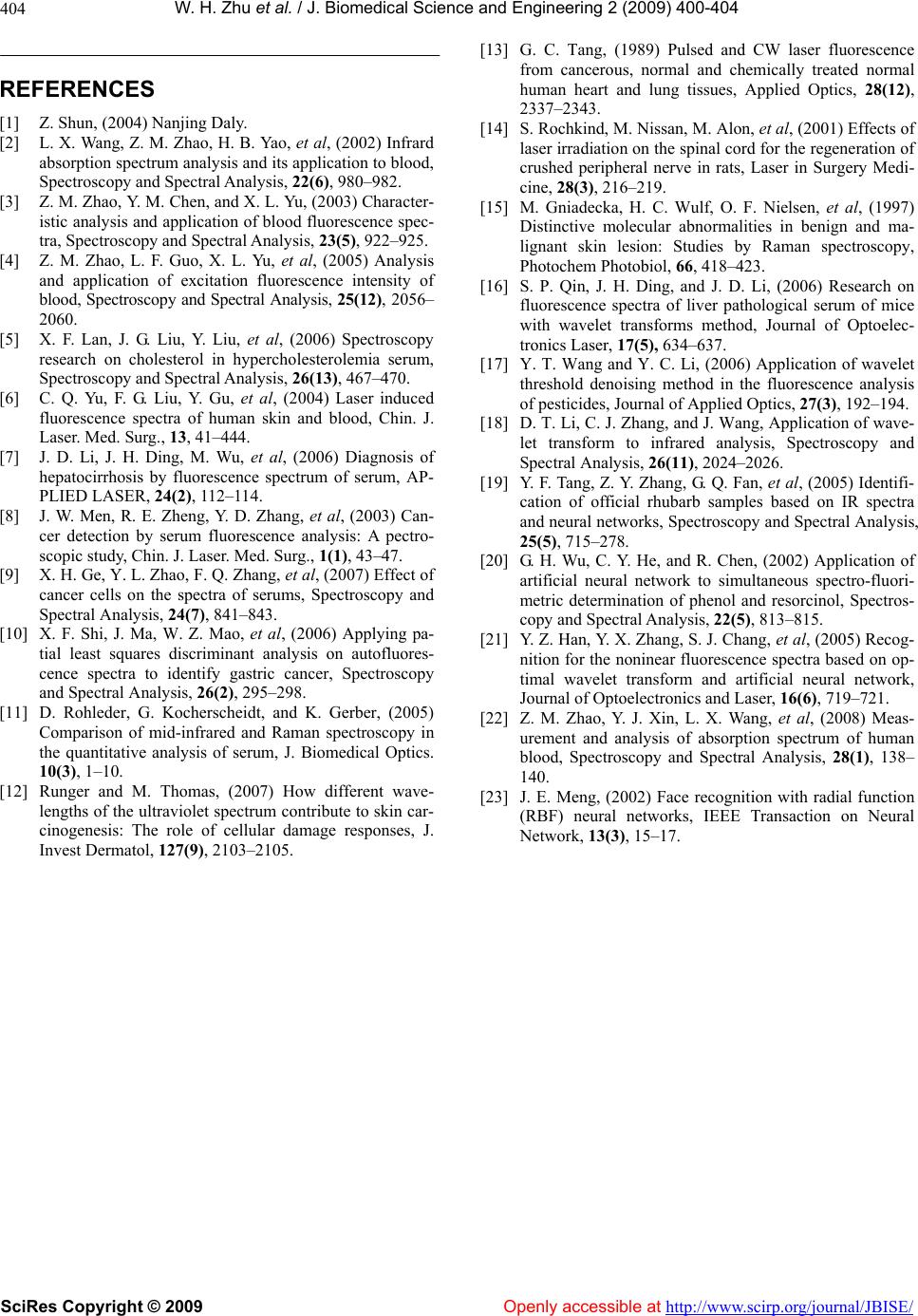
W. H. Zhu et al. / J. Biomedical Science and Engineering 2 (200 9) 400-404
SciRes Copyright © 2009 Openly accessible at http://www.scirp.org/journal/JBISE/
404
REFERENCES
[1] Z. Shun, (2004) Nanjing Daly.
[2] L. X. Wang, Z. M. Zhao, H. B. Yao, et al, (2002) Infrard
absorption spectrum analysis and its application to blood,
Spectroscopy and Spectral Analysis, 22(6), 980–982.
[3] Z. M. Zhao, Y. M. Chen, and X. L. Yu, (2003) Character-
istic analysis and application of blood fluorescence spec-
tra, Spectroscopy and Spectral Analysis, 23(5), 922–925.
[4] Z. M. Zhao, L. F. Guo, X. L. Yu, et al, (2005) Analysis
and application of excitation fluorescence intensity of
blood, Spectroscopy and Spectral Analy sis, 25(12), 2056–
2060.
[5] X. F. Lan, J. G. Liu, Y. Liu, et al, (2006) Spectroscopy
research on cholesterol in hypercholesterolemia serum,
Spectroscopy and Spectral Analysis, 26(13), 467–470.
[6] C. Q. Yu, F. G. Liu, Y. Gu, et al, (2004) Laser induced
fluorescence spectra of human skin and blood, Chin. J.
Laser. Med. Surg., 13, 41–444.
[7] J. D. Li, J. H. Ding, M. Wu, et al, (2006) Diagnosis of
hepatocirrhosis by fluorescence spectrum of serum, AP-
PLIED LASER, 24(2), 112–114.
[8] J. W. Men, R. E. Zheng, Y. D. Zhang, et al, (2003) Can-
cer detection by serum fluorescence analysis: A pectro-
scopic study, Chin. J. Laser. Me d. Surg., 1(1), 43–47.
[9] X. H. Ge, Y. L. Zhao, F. Q. Zhang, et al, (2007) Effect of
cancer cells on the spectra of serums, Spectroscopy and
Spectral Analysis, 24(7), 841–843.
[10] X. F. Shi, J. Ma, W. Z. Mao, et al, (2006) Applying pa-
tial least squares discriminant analysis on autofluores-
cence spectra to identify gastric cancer, Spectroscopy
and Spectral Analysis, 26(2), 295–298.
[11] D. Rohleder, G. Kocherscheidt, and K. Gerber, (2005)
Comparison of mid-infrared and Raman spectroscopy in
the quantitative analysis of serum, J. Biomedical Optics.
10(3), 1–10.
[12] Runger and M. Thomas, (2007) How different wave-
lengths of the ultraviolet spectrum contribute to skin car-
cinogenesis: The role of cellular damage responses, J.
Invest Dermatol, 127(9), 2103–2105.
[13] G. C. Tang, (1989) Pulsed and CW laser fluorescence
from cancerous, normal and chemically treated normal
human heart and lung tissues, Applied Optics, 28(12),
2337–2343.
[14] S. Rochkind, M. Nissan, M. Alon, et al, (2001) Effects of
laser irradiation on the spinal cord for the regeneration of
crushed peripheral nerve in rats, Laser in Surgery Medi-
cine, 28(3), 216–219.
[15] M. Gniadecka, H. C. Wulf, O. F. Nielsen, et al, (1997)
Distinctive molecular abnormalities in benign and ma-
lignant skin lesion: Studies by Raman spectroscopy,
Photochem Photobiol, 66, 418–423.
[16] S. P. Qin, J. H. Ding, and J. D. Li, (2006) Research on
fluorescence spectra of liver pathological serum of mice
with wavelet transforms method, Journal of Optoelec-
tronics Laser, 17(5), 634–637.
[17] Y. T. Wang and Y. C. Li, (2006) Application of wavelet
threshold denoising method in the fluorescence analysis
of pesticides, Journal of Applied Optics, 27(3), 192–194.
[18] D. T. Li, C. J. Zhang, and J. Wang, Application of wave-
let transform to infrared analysis, Spectroscopy and
Spectral Analysis, 26(11), 2024–2026.
[19] Y. F. Tang, Z. Y. Zhang, G. Q. Fan, et al, (2005) Identifi-
cation of official rhubarb samples based on IR spectra
and neural networks, Spectroscopy and Spectral Analysis,
25(5), 715–278.
[20] G. H. Wu, C. Y. He, and R. Chen, (2002) Application of
artificial neural network to simultaneous spectro-fluori-
metric determination of phenol and resorcinol, Spectros-
copy and Spectral Analysis, 22(5), 813–815.
[21] Y. Z. Han, Y. X. Zhang, S. J. Chang, et al, (2005) Recog-
nition for the noninear fluorescence spectra based on op-
timal wavelet transform and artificial neural network,
Journal of Optoelectronics and Laser, 16(6), 719–721.
[22] Z. M. Zhao, Y. J. Xin, L. X. Wang, et al, (2008) Meas-
urement and analysis of absorption spectrum of human
blood, Spectroscopy and Spectral Analysis, 28(1), 138–
140.
[23] J. E. Meng, (2002) Face recognition with radial function
(RBF) neural networks, IEEE Transaction on Neural
Network, 13(3), 15–17.